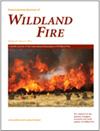Multi-century times-since-fire and prior fire interval determine biomass carbon stocks in obligate-seeder eucalypt woodlands
IF 2.9
3区 农林科学
Q1 FORESTRY
引用次数: 0
Abstract
Background Understanding the influence of fires on terrestrial carbon stocks is important for informing global climate models and underpinning land management-based carbon markets. Aims To quantify biomass carbon in south-western Australia’s Great Western Woodlands – the world’s largest extant Mediterranean-climate woodland – with time-since-fire and prior fire interval. Methods Plot-based measurement of live and dead tree and shrub size, woody debris volume and litter mass across a ~400-year chronosequence to calculate biomass carbon. Key results Biomass carbon increased with time-since-fire, reaching >65 Mg C ha−1, although the rate of increase declined in mature woodlands. Biomass carbon decreased after fire in these obligate-seeder woodlands, while a longer prior fire interval buffered carbon fluxes through retained large standing dead trees and fallen woody debris. Conclusions The current age class distribution of the ~95,000 km2 of eucalypt woodlands in the region may support ~0.453 Pg C. Further refinement of carbon estimates explicitly considering variation in woodland type and climate, a continuous woodland age distribution and soil carbon are required to underpin a carbon methodology. Implications Biomass carbon would be maximised by reducing the extent of bushfires impacting woodlands, focussing on existing mature stands that support the greatest carbon stocks.多世纪火灾后时间和火灾前时间间隔决定桉树林地的生物质碳储量
背景 了解火灾对陆地碳储量的影响对于建立全球气候模型和基于土地管理的碳市场非常重要。目的 量化澳大利亚西南部大西部林地--世界上现存最大的地中海气候林地--的生物量碳,并将其与火灾后的时间和火灾前的时间间隔挂钩。方法 在约 400 年的时间序列中,以地块为基础测量活树和死树以及灌木的大小、木质碎屑体积和枯落物质量,计算生物质碳。主要结果 生物质碳随着火灾后时间的推移而增加,达到大于 65 兆克碳公顷-1,尽管在成熟林地中增加的速度有所下降。这些强制性播种林地的生物量碳在火灾后有所减少,而火灾前较长的间隔时间则通过保留大型枯树和倒下的木质碎屑缓冲了碳通量。结论 该地区约 9.5 万平方公里桉树林的当前树龄分布可支持约 0.453 Pg C。需要进一步完善碳估算,明确考虑林地类型和气候的变化、连续的林地树龄分布和土壤碳,以支持碳方法。影响 通过降低丛林火灾对林地的影响程度,最大限度地提高生物质碳储量,重点关注支持最大碳储量的现有成熟林分。
本文章由计算机程序翻译,如有差异,请以英文原文为准。
求助全文
约1分钟内获得全文
求助全文
来源期刊
CiteScore
5.50
自引率
9.70%
发文量
67
审稿时长
12-24 weeks
期刊介绍:
International Journal of Wildland Fire publishes new and significant articles that advance basic and applied research concerning wildland fire. Published papers aim to assist in the understanding of the basic principles of fire as a process, its ecological impact at the stand level and the landscape level, modelling fire and its effects, as well as presenting information on how to effectively and efficiently manage fire. The journal has an international perspective, since wildland fire plays a major social, economic and ecological role around the globe.
The International Journal of Wildland Fire is published on behalf of the International Association of Wildland Fire.

 求助内容:
求助内容: 应助结果提醒方式:
应助结果提醒方式:


